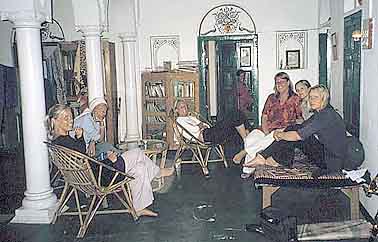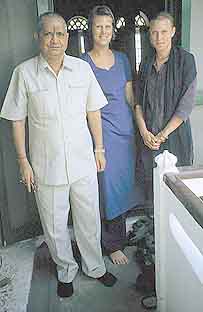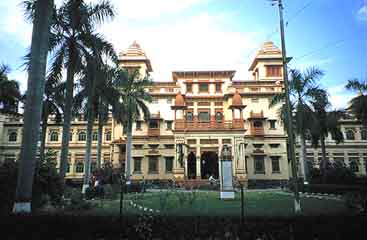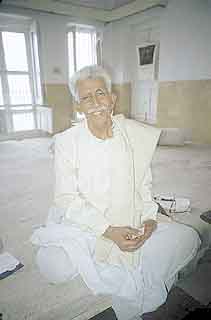SWEDISH SOUTH ASIAN STUDIES NETWORK
Lars Eklund’s Report from Varanasi:
Swedish Study Centre for Indian Culture
Meeting with Mr Om Prakash Sharma
Meeting with Ms Inger Wiklund Jha
Meeting at Dept of History of Art & Tourism management, BHU
Meeting with Vrinda Dar, working for Kautilya Society, Association for Intercultural Dialogue
Tuesday 12 March 2002
Arrived to Varanasi by the Kashi Vishwanath Express train
from Delhi at 5.30 in the morning, and took a taxi to Ganga View Hotel
at Assi Ghat, the southernmost bathing ghat in Varanasi.
The whole atmosphere is loaded with religious fervour, and Hindu pilgrims
pass in large numbers through the street in front of the hotel on their
way to the bathing ghats and numerous temples along the shore. 12 March
is a Hindu religious holiday – Shiv Ratri (Shiva´s night) –
and that is the reason for the big crowd.
It is a totally different world from the cosmopolitan and modern capital
city New Delhi, from which I have just come. As unusual as it is to wear
casual dress and sandals in Delhi, just as unusual it is to wear shoes
and a European jacket here, as I did on my arrival. Many Western tourists
stay for a long time in Varanasi, and quite a number of them have adapted
themselves totally in dress and behaviour, and a few are even seen practising
yoga on the ghats, and staying with sadhus, smoking the chillum.
Indeed a fascinating experience after spending nearly a week in the guarded
luxury enclaves of the rich and mighty Indian elite in South Delhi, and
meeting famous researchers at the top universities of the capital.
 Swedish
Study Centre for Indian Culture
Swedish
Study Centre for Indian Culture
Ganga Mahal is located 100 meters north of the hotel. This
beautiful residential building which is also overlooking the Ganga and
the bathing ghats belongs to the Maharaja of Varanasi. The first floor
is at the disposal of Karlstad University (KU) as a Swedish study centre.
KU has long-standing relations with Varanasi and the Hindu Banaras University
(BHU), especially in the following fields:
• Dept of Cultural Geography and Tourism, where Prof Gerhard Gustafsson and Kristina Lejonhud from KU are working on a project in co-operation with Prof Rana P B Singh at BHU.
• Dept of Religions, where ass prof Kjell Härenstam regularly brings students from KU to Varanasi. Ass prof Marc Katz at the same department did his PhD thesis in 1993 on the religious traditions among children of Assi (where the hotel is located), and he has also produced two documentary films on religion in Varanasi.
• Dept for Teacher´s Training, where every year a group of students go to either Varanasi or Dharamsala for a period of 10 weeks, led by P O Fjällsby.
For the first time a group of pre-school teaching students from the Division for Educational Sciences has this Spring come to do field work in Varanasi. They arrived in February along with Inga-Lill Fjällsby, and will stay for five weeks at Ganga Mahal. I-L Fjällsby went back to Sweden in the beginning of March and for the last weeks the students work on their own, doing field studies at pre-schools of different styles in and around Varanasi, after which they shall present their results as final term papers. More information on Karlstad University’s India Programme.
I went to see them, eight women and one man (another two students were staying at a project site outside Varanasi), and had a long discussion about their experiences so far. They were all very positive to the basic idea of going to Varanasi for field studies, and they had learnt much about India, a country which only one of the students had visited previously. They were also extremely positive to the palatial place they were accommodated in, and the good services they are offered by Mr Om Prakash Sharma, the co-ordinator working at Ganga Mahal. As it was a holiday he was not in his office today, so I will met him tomorrow.
A disappointment, though, was the fact that only a couple
of the students had got possibility of good objects for their field studies.
After arriving in Varanasi it turned out that most of the pre-schools
which were supposed to receive the students, could not fulfil the promises
given, as the pre-school teachers found the presence of the Swedish students
disturbing – especially at this time of the year which is the season
for intensive studies to pass the examinations. Only two students, placed
at a Krishna Murti-school (inspired by the Montessori tradition)
had been given their due attention.
So instead of spending full days at pre-schools most of the Swedish students
were allowed only short stays at the respective pre-schools, and sometimes
not at all. Still they were convinced that they would be able to make
papers out of what they have seen at several study visits.
Wednesday 13 March 2002
 Meeting
with Mr Om Prakash Sharma, at the Swedish Study Centre for Indian Culture
Meeting
with Mr Om Prakash Sharma, at the Swedish Study Centre for Indian Culture
Om Prakash Sharma, generally called Omji, is employed part time by Karlstad University to work as a co-ordinator at the Study centre. He is also working as a language teacher (Hindi) at the BHU. Omji previously has been working for the American Peace Corps in the 1970´s and later on for the Sociology dept of London University (from which he has got a Masters degree), the Himachal Pradesh state government, and the American Wisconsin programme. He has been in touch with Karlstad University since 1986-87.
That year he organised a study tour to Nepal for teachers
training students led by P O Fjällsby, and in 1988 a new batch of
student went to Varanasi, staying at hotel. Marc Katz had at that time
already good connections in Varanasi after spending a long time there,
working on his thesis. This resulted in a formal agreement on co-operation
between Karlstad University and Banaras Hindu University, BHU, in 1988.
The agreement makes it possible for Swedish students to take part in courses
of relevance at BHU, e g in Hindi, Music, Sociology, Indology, or any
other of the 165 departments at the university.
The study centre at Ganga Mahal, close to Assi Ghat, has been rented from
the Maharaja of Varanasi since 1995. It can accommodate maximum 10 students
at a time, who are offered board and lodging, two computers and one Internet
connection. When the number of students exceed 10 the rest are booked
at Temple Hotel nearby.
Karlstad University sends groups of students to Varanasi
every year, not only teachers training students but also frequently students
from the Dept of Religions (groups led by Marc Katz and Kjell Härenstam),
Dept of Geography and Tourism, and Dept of Social Work and Health
are coming, and right now a group of pre-school teaching students are
here for the first time.
Even though the centre is run by Karlstad University several other Swedish
institutions have take the opportunity of using Ganga Mahal, e g:
• Uppsala University, the departments of History of Religions, and Environment studies.
• Swedish Agricultural University. I had the opportunity to see a recent report written by two students, Charlotte Furmark and Malin Larson (Minor Field Studies no 174) after their stay in Varanasi, on “Bioavailable Pollutants and their effects on fish reproduction in the Ganges river”.
•Österlens folk high school has previously used Ganga Mahal for three groups of students, when they had courses led by Janina Lundell.
• Linköping University, the departements of Religion, and the Faculty of Health Sciences. The later has had students here led by Nils Clasén and Els-Marie Anbäcken.
• Svenska Naturskyddsföreningen, SNF, which is engaged in the project to clean the Ganga river, and is partly funding a laboratory (run by Prof Bhadra Mishra, at the Dept of Engineering at BHU) nearby Ganga Mahal, and which alo involves researchers from Kungliga Tekniska Högskolan in Stockholm.
Omji informed about some recent developments. In March 2001
Linköping University signed a separate MOU on students exchange with
the Mahatma Gandhi Kashi Vidhyapeeth University in Varanasi. And
Karlstad University is also under way to establish a co-operation with
this university regarding teachers training students, to increase the
possibilities in Varanasi.
Karlstad has already, since 1995, an agreement also with the Tibetan
Institute for Higher Education at Dharamsala, sending students there.
This is usually done when groups of teacher training students are sent
to India in the months of April and May, when it is extremely hot in Varanasi
but more bearable temperatures in Dharamsala.
Meeting with Ms Inger Wiklund Jha, at her residence at Gangotri Vihar Nagar
Inger came to Varanasi for the first time in 1990 as a student
at Karlstad University. She married and has stayed on in Varanasi ever
since, now living in a nice house just south of the city. For some years
in the 1990s she continued her academic studies, as a distance student
in Indology at Stockholm University (she went to Sweden in the summer,
and did her examinations then), up to the D level. She could not complete
her studies though as her husband fell seriously ill and she has had to
take care of him for the past several years.
Inger teaches Hindi at BHU, at courses run for foreigners. Till 1995 she
was also actively taking part in the Karlstad University student groups
coming to Varanasi, but not since Ganga Mahal was established as a Swedish
study centre. Though the years she has regularly contributed learned articles
on Varanasi for the Swedish magazine SYDASIEN.
Meeting at Banaras Hindu University, Dept of History of Art & Tourism management
 Present:
Prof Rana P B Singh, Geography,
Prof Deena Bandhu Pandey, Art History, Visiting
faculty member Pravin S Rana,
Tourism management, and Visiting faculty member Ms Nandita
Pandey, Tourism management
Present:
Prof Rana P B Singh, Geography,
Prof Deena Bandhu Pandey, Art History, Visiting
faculty member Pravin S Rana,
Tourism management, and Visiting faculty member Ms Nandita
Pandey, Tourism management
Professor Rana P B Singh, who has a long-lasting relation
with Karlstad University is also a keen supporter of SASNET after taking
part in our workshop on Global netwoking in
August 2001, and who spreads praise about our network in Varanasi, picked
me up at the hotel and rode me on his scooter to the beautiful campus
area of BHU.
BHU was founded in 1916 by Pandit Madan Mohan Malaviya with co-operation
of the great personality and national leader Dr Annie Besant. The
university, which is situated on the bank of the river Ganga, is a separate
entity from Varanasi city, and it has besides teaching and research-cum-residential
institutions its own set up of public institutions, banks, library, and
in the centre of the campus an impressing temple to Lord Vishwanath.
BHU is recognised as a central university, and has all the
faculties represented, plus three institutes – Institute of Technology,
Institute of Medical Sciences and the Institute of Agriculture –
and four Interdisciplinary centres, altogether 165 departments and around
18.000 students.
We went to the Dept of History of Art, founded in 1950 and considered
among the best of its kind in India. A few years ago the department was
designated to take charge for vocational courses in Tourism and Travel
Management, and in 1999 also postgraduate courses were introduced. The
department has along with this organised two national seminars on Dimensions
of Tourism in Varanasi and on Pilgrimage Tourism.
At present 60 students are doing undergraduate studies at the department,
whereas 30–35 are doing postgraduate/research studies.
I had a stimulating conversation with professor Pandey and the two young visiting lecturers, who all were keen on establishing contacts with Swedish departments dealing with tourism. They have already had contacts with Karlstad University, a Linnaeus Palme exchange programme had been planned, but it had not been possible yet to find enough Swedish participants to finalise it. Students here are most willing to take part in such a programme.
Meeting at Dept of Agricultural Extension & Mass Communication, Institute of Agricultural sciences, BHU
with Rana P B Singh and the Head of the department, Prof Deepak De.
Professor De is also the Vice president of the Global Communication Research Association, based at Macquarie University, Sydney, Australia.
The department is working on the questions of technology
transfer, and its reception among farmers. Prof De stressed that this
involves social as well as political, economical, psychological and other
aspects. Among subjects under study are how to create awareness about
the toxic consequences of using pesticides in agriculture and not keeping
the safety prescriptions; how the greediness among commercial farmers
thereby kills people; and the urgent need for popular education.
An International Seminar on Communication and Sustainable Development
in Agriculture is planned to be held at BHU 7–9 January, 2003, and
SASNET will definitely give publicity to this important seminar.
At present the department has 14 MSc students and 10 PhD students besides
round 80 undergraduates.
The prospects for co-operation between this department at BHU and Swedish
institutions should be good, and I promised to advertise about it through
SASNET.
Varanasi 14 mars 2002
Meeting with Vrinda Dar, working for Kautilya Society, Association for Intercultural Dialogue
Web page: http://www.kautilyasociety.org/
Ms Vrinda Dar came to
see me at the hotel along with Prof Rana P B Singh. She informed about
the advocacy work her NGO is doing in order to preserve the cultural heritage
of Varanasi, and try to get the city put on UNESCO´s
list of World Heritages.
She informed about her organisation´s work to document architecture
and art, and their efforts in seeking co-operation with the city administration.
As there at present is no department for Architecture and Town planning
at BHU she said that plans are under way to start a special school for
this in Varanasi. For that reason they are looking for possible help from
outside, e g could Swedish students of architecture play a part in that?
Vrinda Dar also mentioned that she has an uncle, Ashok Dar, who
previously has worked for FAO, is married to a Swedish lady and has been
teaching at the Swedish Agricultural University in Uppsala.
Meeting with Bhadra Mishra, Profesor of Hydraulic Engineering at BHU, founder of Sankat Mochan Foundation, and Mahant of the Sankat Mochan temple, Varanasi
 Mr
Om Prakash Sharma of the Swedish Study Centre arranged for a meeting with
the Mahant (Hindu religious leader residing at Tulsi Ghat). Bhadra
Mishra is well-known the World over for his work with the Swatcha
Ganga Project, i e Clean Ganga, and he has been portrayed in several international
magazines in recent years because of his unique combination of being a
trained scientist and at the same time being very much an integral part
of the religious traditions concerning the river Ganga.
Mr
Om Prakash Sharma of the Swedish Study Centre arranged for a meeting with
the Mahant (Hindu religious leader residing at Tulsi Ghat). Bhadra
Mishra is well-known the World over for his work with the Swatcha
Ganga Project, i e Clean Ganga, and he has been portrayed in several international
magazines in recent years because of his unique combination of being a
trained scientist and at the same time being very much an integral part
of the religious traditions concerning the river Ganga.
Svenska Naturskyddsföreningen, SNF, is involved and runs a
Sida-financed project to create environmental awareness of the water pollution
among the inhabitants of the ghat areas in Varanasi. This project is controversial
(as Sidsel Hansson pointed out in her
doctoral thesis, History of Religion at Lund University, 2001) as
Prof Mishra advocates quite different solutions to the pollution problem
than what the government of India stands for.
Sankat Mochan Foundation has around 150 members, five active board members
plus an eight people staff and many volunteers turning up from several
countries. In Sweden an organisation called Ganges Vänner
has been created in Karlstad. Among its members are Eva Nordlöf
and Bertil Lindahl, who use to come regularly to Varanasi and work
as volunteers for 3-4 weeks a year.
SNF has contributed financially to a research laboratory at Tulsi Ghat,
where the work now is performed by two scientists, under supervision from
Prof Upadhyay at BHU.
Prof Bhadra mentioned that several persons from Swedish universities have
been in some way involved, among them a researcher from Uppsala University
now working in Stockholm, and then of course Marc Katz in Karlstad,
who has made a documentary film along with him.
Information on the Swatcha Ganga project is found at the web site http://www.cleanganga.com,
which is produced by the Swedish international campaign coordinator Roger
Choate. More information on a web
page published by The Stockholm Partnerships for Sustainable Cities.
Prof Bhadra ended up by inviting interested Swedish researchers to come
to Varanasi as volunteers. The lab can be used by them. More information on Prof. Bhadra’s web page, http://www.sankatmochanfoundationonline.org/ ![]()
Lars Eklund
SASNET - Swedish South Asian Studies Network/Lund
University
Address: Scheelevägen 15 D, SE-223 70 Lund, Sweden
Phone: +46 46 222 73 40
Webmaster: Lars Eklund
Last updated
2011-01-19
SASNET - Swedish South Asian Studies Network/Lund
University
Address: Scheelevägen 15 D, SE-223 70 Lund, Sweden
Phone: +46 46 222 73 40
Webmaster: Lars Eklund
Last updated
2011-01-19
